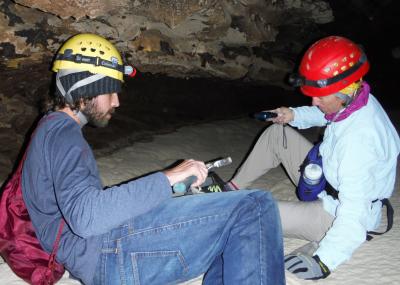NASA grant helps NMSU astronomy student's search for microbial life

New Mexico State University student Kyle Uckert is working on the development of instrumentation to help identify signs of life on bodies of the solar system. He has been selected as one of 65 graduate students in the 2013 class of NASA Space Technology Research Fellows and will receive funding for his work for three years.
Uckert, who is a graduate student in the College of Arts and Science's Astronomy Department, is developing a two-step laser time-of-flight mass spectrometer to isolate materials within rocks, and identify and characterize biosignatures within geological samples.
"I will identify the spectral characteristics of amino acids and other chains of basic organic compounds essential to life on Earth," he said. "The mass spectrometer uses a laser to ablate materials off of rocks. The plasma-like material is then accelerated into a detector, which helps measure chemical constituents of samples. We're able to infer from this whether there's any organic matter and identify any signs of present or past life on the rock."
As part of his research, Uckert is studying the materials found in cave rocks. He said he hopes the instrumentation he is developing will one day be used on landed or roving space missions.
"We're starting to study life in caves on Earth," he explained. "Caves are a good analog for extreme environments where we might hope to find life elsewhere in the solar system. They're sheltered from ultraviolet light. There's also the potential for water to be below the surface of other planetary bodies.
"The instrument will hopefully be flown to another planetary body to help us look for life there. My role is to help identify what the best way to look for life here on Earth is, so that we can apply that knowledge elsewhere in the solar system. I'll be doing that for the next three years."
Uckert uses three types of devices to study and analyze the materials: a two-step laser desorption time-of-flight mass spectrometer for organic and biosignature identification; infrared and ultraviolet reflectance spectrometers, complimentary instrumentation at NMSU's geology and electrical engineering departments; and "a laser-induced breakdown spectrometer to quantify the effectiveness of these instruments as biomarker identification tools."
Through the fellowship, Uckert will also have the opportunity to work with a mentor at a NASA institution, Stephanie Getty. He will spend time at the Goddard Space Flight Center utilizing the equipment.
Uckert, who anticipates graduating in 2016, earned his bachelor's degree at Ohio University. He chose NMSU for his graduate studies because his now-adviser Nancy Chanover was working on the project, and he wanted to be involved. He also works with Nancy McMillan of geological sciences and David Voelz of electrical engineering.
"The most fascinating thing about this research is that the technology that we're developing has potential to impact future missions to other planets," he said. "The most challenging thing is trying to decide what constitutes something that has life in it, or trying to find the life. We look for life in solar system based on what we think life should look like. We really only have one data point for that. We don't know for sure whether life in other bodies will have the same properties, but it's the best place we have to start."
Uckert is the first NMSU student to receive this NASA fellowship. The grant amounts to roughly $180,000, and includes a student stipend, a travel allowance, tuition costs, a faculty advisor allowance and support for him to spend 10 weeks each summer working at a NASA center with a research mentor.
Still not sure what his plans after graduation are, Uckert said he hopes to continue working on this type of development.
"Ideally, it would be great to have a career in instrumentation development and planetary science," he said.
To learn more about Uckert's research, visit http://www.nasa.gov/spacetech/strg/2013_nstrf_uckert.html.


